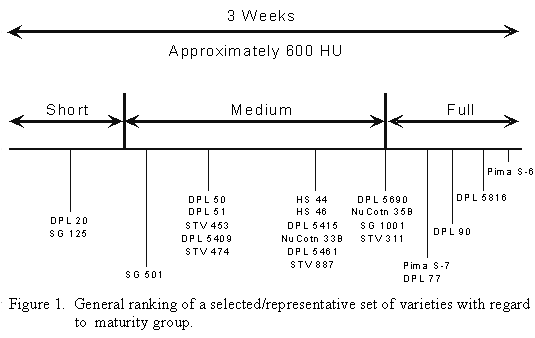General Maturity Groups for Cotton Varieties
(Publication az1214)
(PDF file version, 32KB)
by Jeffrey C. Silvertooth,
Extension Agronomist - Cotton
Three maturity groupings are often used to classify cotton varieties, consisting of: 1) short season or more determinate plants, 2) medium season varieties, and 3) long or full season varieties which are more indeterminate in nature. Classification of cotton varieties into one of these three categories is not necessarily straightforward in all cases. In fact, it easily can become a process of "splitting hairs" when making maturity grouping designations for cotton varieties. Nevertheless, maturity designations are commonly assigned to most commercially available varieties, which can effect selection and management.
The attached figure (Figure 1) illustrates my attempt at separating a set of representative varieties among the three maturity groups along a maturity continuum ranging from most determinate (short season) on the left to most indeterminate (full season) varieties on the right. This figure was developed based upon plant growth data collected from our agronomic research program conducted at numerous locations across the state. Maturity classification was based primarily upon crop progression toward cut-out, considering only cases with a strong boll load where no plant stresses had limited growth. It is important to note from Figure 1 that the total range from short to full season varieties only involves a span of about three weeks (600 heat units, HU 86/55° F), considering a common/optimum planting date, adequate boll load, and no growth-limiting stresses. Placement of varieties for this type of comparison are general in nature and not absolute.
Management Implications
There are several implications which one might consider in reviewing this
type of information for variety selection and management.
- All varieties can realize strong yield potentials with an early/optimum planting (soil temperatures of 60° F+ for several consecutive days at 8:00 A.M. and a favorable five-day forecast). However, it is very important that full season varieties be planted early for full yield potential. One of the common characteristics associated with a full season variety is its drop in yield potential with a delay in planting and an increase in its vegetative tendencies. Full season varieties should be planted before 700 HU have been accumulated since January 1 (HU/Jan. 1). Medium maturity varieties generally do best if planted before 800 HU/Jan. 1. Short season varieties have the greatest flexibility in planting and can be planted up to about 1,000 HU/Jan. 1 before suffering losses in yield potentials.
- If one wants to maintain an option of producing a top-crop (development of a second fruiting cycle following cut-out), a full season variety is more appropriate for this type of strategy. With increasing determinance, cotton plants have less of a top-crop potential.
- More determinate varieties are more sensitive to stresses, particularly water stress.

|
Issued in furtherance of Cooperative Extension work, acts of May 8 and June 30, 1914, in cooperation with the U.S. Department of Agriculture, James A. Christenson, Director Cooperative Extension, College of Agriculture and Life Sciences, The University of Arizona.
The University of Arizona is an equal opportunity, affirmative action institution. The University does not discriminate on the basis of race, color, religion, sex, national origin, age, disability, veteran status, or sexual orientation in its programs and activities.
Any products, services, or organizations that are
mentioned, shown, or indirectly implied in this web document do not imply
endorsement by The University of Arizona.
Information provided by Jeffrey C. Silvertooth, silver@ag.arizona.edu
Extension Agronomist - Cotton, College of Agriculture, The University of Arizona.
Material written April 1998.
State-wide:
Central Eastern
Western Yuma
Regional: Maricopa
Marana Safford
Yuma
Home | Cotton | Advisories
document located at: http://cals.arizona.edu/crops/cotton/varieties/maturity_groups.html
Copyright © 2001 University of Arizona,
College of Agriculture and Life Sciences
Webmaster: Al Fournier (acis@ag.arizona.edu)